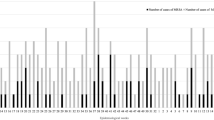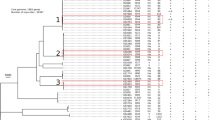Abstract
Methicillin-resistant Staphylococcus aureus (MRSA) formerly colonized and infected only inpatients in hospitals, but have been reported in community settings worldwide over the last 20 years. In France, the prevalence of such MRSA remains low and outbreaks have, until now, been mainly due to the ST80 clone. However, there were two outbreaks of MRSA clone ST-USA300 recently in France, including one involving children. To investigate epidemiological developments, we studied the 77 MRSA isolated from pediatric patients hospitalized between 2008 and 2013 in three French hospitals. The median incidence of MRSA was stable and low (0.137 per 100 admissions). The prevalence of Panton–Valentine leukocidin (PVL)-positive MRSA was high (33.8 %). The 26 PVL-positive MRSA were genetically diverse, with two clones being predominant: ST80 (12 isolates, 46.1 %) and ST8-USA300 (8 isolates, 30.8 %). The incidence of ST8-USA300 increased over the 6-year period. We believe that screening for ST8-USA300 should be improved: medical biologists should be encouraged to search for PVL genes in all MRSA isolates recovered from abscesses, whatever the susceptibility pattern of the isolate, and not only when suggestive of ST80.


Similar content being viewed by others
References
Vandenesch F, Naimi T, Enright MC et al (2003) Community-acquired methicillin-resistant Staphylococcus aureus carrying Panton–Valentine leukocidin genes: worldwide emergence. Emerg Infect Dis 9:978–984
Chua KYL, Seemann T, Harrison PF et al (2011) The dominant Australian community-acquired methicillin-resistant Staphylococcus aureus clone ST93-IV [2B] Is highly virulent and genetically distinct. PloS One 6:e25887
Tristan A, Bes M, Meugnier H et al (2007) Global distribution of Panton–Valentine leukocidin-positive methicillin-resistant Staphylococcus aureus, 2006. Emerg Infect Dis 13:594–600
Diekema DJ, Richter SS, Heilmann KP et al (2014) Continued emergence of USA300 methicillin-resistant Staphylococcus aureus in the United States: results from a nationwide surveillance study. Infect Control Hosp Epidemiol 35:285–292
Robert J, Tristan A, Cavalié L et al (2011) Panton–Valentine leukocidin-positive and toxic shock syndrome toxin 1-positive methicillin-resistant Staphylococcus aureus: a French multicenter prospective study in 2008. Antimicrob Agents Chemother 55:1734–1739
Rolo J, Miragaia M, Turlej-Rogacka A et al (2012) High genetic diversity among community-associated Staphylococcus aureus in Europe: results from a multicenter study. PLoS One 7:e34768
Fournier S (2013) Épidémie à Staphylococcus aureus résistant à la méticilline (SARM) exprimant la leucocidine de Panton Valentine dans un service de soins de suite et de réadaptation. La lettre du signalement des infections nosocomiales, n°9, Décembre 2013. Available online at: http://www.invs.sante.fr/esin
Baud O, Giron S, Aumeran C et al (2014) First outbreak of community-acquired MRSA USA300 in France: failure to suppress prolonged MRSA carriage despite decontamination procedures. Eur J Clin Microbiol Infect Dis 33:1757–1762
Comité de l’Antibiogramme de la Société Française de Microbiologie. Communiqué 2013. Paris, France: SFM ed; 2003. Home page at: http://www.sfm-microbiologie.org
Jarraud S, Mougel C, Thioulouse J et al (2002) Relationships between Staphylococcus aureus genetic background, virulence factors, agr groups (alleles), and human disease. Infect Immun 70:631–641
Monecke S, Luedicke C, Slickers P, Ehricht R (2009) Molecular epidemiology of Staphylococcus aureus in asymptomatic carriers. Eur J Clin Microbiol Infect Dis 28:1159–1165
Murchan S, Kaufmann ME, Deplano A et al (2003) Harmonization of pulsed-field gel electrophoresis protocols for epidemiological typing of strains of methicillin-resistant Staphylococcus aureus: a single approach developed by consensus in 10 European laboratories and its application for tracing the spread of related strains. J Clin Microbiol 41:1574–1585
Tristan A, Rasigade JP, Ruizendaal E et al (2012) Rise of CC398 lineage of Staphylococcus aureus among infective endocarditis isolates revealed by two consecutive population-based studies in France. PLoS One 7:e51172
Creech CB 2nd, Kernodle DS, Alsentzer A, Wilson C, Edwards KM (2005) Increasing rates of nasal carriage of methicillin-resistant Staphylococcus aureus in healthy children. Pediatr Infect Dis J 24(7):617–621
Thurlow LR, Joshi GS, Clark JR et al (2013) Functional modularity of the arginine catabolic mobile element contributes to the success of USA300 methicillin-resistant Staphylococcus aureus. Cell Host Microbe 13(1):100–107
Haut Conseil de la Santé Publique (2014) Recommandations sur la conduite à tenir lors d’épisodes de cas groupés d’infections cutanées suppuratives liées aux souches de Staphylococcus aureus résistant à la méticilline (SARM Co)
Gbaguidi-Haore H, Thouverez M, Couetdic G, Cholley P, Talon D, Bertrand X (2009) Usefulness of antimicrobial resistance pattern for detecting PVL- or TSST-1-producing meticillin-resistant Staphylococcus aureus in a French university hospital. J Med Microbiol 58(Pt 10):1337–1342
Conflict of interest
The authors declare that they have no conflict of interest.
Author information
Authors and Affiliations
Corresponding author
Rights and permissions
About this article
Cite this article
van der Mee-Marquet, N., Poisson, DM., Lavigne, JP. et al. The incidence of Staphylococcus aureus ST8-USA300 among French pediatric inpatients is rising. Eur J Clin Microbiol Infect Dis 34, 935–942 (2015). https://doi.org/10.1007/s10096-014-2308-3
Received:
Accepted:
Published:
Issue Date:
DOI: https://doi.org/10.1007/s10096-014-2308-3




